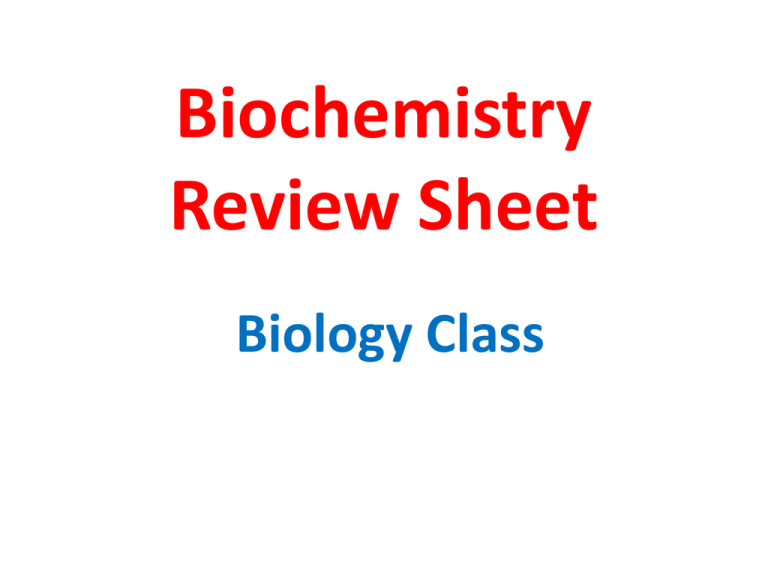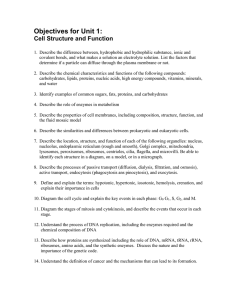Biochemistry Review Sheet Biology Class
advertisement

Biochemistry Review Sheet Biology Class DISACCHARIDE MONOSACCHARIDE AMINO ACID LIPID POLYSACCHARIDE NUCLEOTIDE GIVE MONOMERS FOR: • Proteins: amino acids • Carbohydrates: monosaccharide • Nucleic Acids: nucleotides • Lipids: fatty acids Which elements are found mostly in living organisms? C arbon H ydrogen N itrogen O xygen P hosphorus S ilicon pH ranges • pH range of acids: 1-6.99 • PH range of bases: 7.01-14 • pH for weakest acid: 6.99 • pH for weakest base: 7.01 Name the property of enzymes this represents. Specific shape • What property of enzymes determines function? Shape • What particular function is taking place? Synthesis • Define the term ”substrate.” Molecule that has the chemical reaction Define the following: •Acids: excess H+ ions •Bases: excess OH-ions UNSATURATED FATTY ACID SATURATED FATTY ACID POLYUNSATURATED FATTY ACID What happens at the active site? CHEMICAL REACTION Why enzymes are important? • A fundamental task of proteins is to act as enzymes—catalysts that increase the rate of virtually all the chemical reactions within cells. • Most biological reactions are catalyzed by proteins. • In the absence of enzymatic catalysis, most biochemical reactions are so slow that they would not occur under the mild conditions of temperature and pressure that are compatible with life. Why enzymes are important? • Enzymes accelerate the rates of such reactions by well over a million-fold, so reactions that would take years in the absence of catalyst can occur in fractions of seconds if catalyzed by the appropriate enzyme. • Cells contain thousands of different enzymes, and their activities determine which of the many possible chemical reactions actually take place within the cell. • Enzymes are essential to sustain life. It work together cooperating with vitamins and minerals and act as a catalyst to accelerate chemical reaction. • Because most chemical reactions in biological cells would occur too slowly. Enzymes don't only act as a catalyst. • When the body has an abundance of enzymes, it can protect itself and repair the damage from almost all degenerative disease disorders! • Without enzymes, we age more quickly, get disease earlier in life, and acquire physical impairments and mental retardation as our bodies degenerate. • Neither a human being nor an animal can live without enzymatic function. As it were the leading part of the life activities and it is the source. List the properties of carbon that enables it to form long chains: • can bond with 4 atoms • covalent bonding • forms long chains of carbon • has 4 valence electrons What is the main element of most molecules in living organisms? Carbon • What property of water allows it to help organisms to cool off and maintain body temperature? Evaporation of sweat carries excess heat from body • What property of water keeps lakes and ponds from freezing solid? Less dense ice floating on top of water as an insulation Which property of water does this represent? POLARITY What properties of water make it a universal solvent? •POLAR •COVALENT Enzymes • What does denature mean? nonfunctional • Which kind of molecule may become denatured? enzymes • How does it become denatured? Changes in temperature and pH List functions of Proteins • Structure: hair, horns, muscles, are some examples • Function: hormones, enzymes, and hemoglobin are some examples List functions of carbohydrates • Provide energy • Structure in plants (cellulose) List functions of Lipids • • • • • • • Long term energy storage Cell membrane structure Waxes Steroids Cushioning Protection Insulation Name of this reaction is Dehydration Synthesis (Removal of water to join molecules) Name of this reaction is Hydrolysis (Using water to split a molecule)





